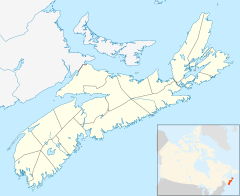
Nova Scotia is a province of Canada, located on its east coast. It is one of the three Maritime provinces and most populous province in Atlantic Canada, with an estimated population of over 1 million as of 2024; it is also the second-most densely populated province in Canada, and second-smallest province by area. The province comprises the Nova Scotia peninsula and Cape Breton Island, as well as 3,800 other coastal islands. The province is connected to the rest of Canada by the Isthmus of Chignecto, on which the province's land border with New Brunswick is located.

Kentville is an incorporated town in Nova Scotia. It is the most populous town in the Annapolis Valley. As of 2021, the town's population was 6,630. Its census agglomeration is 26,929.

Weymouth is a rural village located in Digby County, Nova Scotia on the Sissiboo River near its terminus on Baie Ste. Marie.

Shelburne is a town located in southwestern Nova Scotia, Canada.

Annapolis Royal is a town in and the county seat of Annapolis County, Nova Scotia, Canada. The community, known as Port Royal before 1710, is recognised as having one of the longest histories in North America, preceding the settlements at Plymouth, Jamestown and Quebec. For nearly 150 years, it served as the capital of Acadia and subsequently Nova Scotia until the establishment of Halifax in 1749.

The 84th Regiment of Foot (Royal Highland Emigrants) was a British regiment in the American Revolutionary War that was raised to defend present-day Ontario, Quebec, and Atlantic Canada from the constant land and sea attacks by American Revolutionaries. The 84th Regiment was also involved in offensive action in the Thirteen Colonies; including North Carolina, South Carolina, Georgia, Virginia, and what is now Maine, as well as raids upon Lake Champlain and the Mohawk Valley. The regiment consisted of 2,000 men in twenty companies. The 84th Regiment was raised from Scottish soldiers who had served in the Seven Years' War and stayed in North America. As a result, the 84th Regiment had one of the oldest and most experienced officer corps of any regiment in North America. The Scottish Highland regiments were a key element of the British Army in the American Revolution.

St. Paul's Church is a historically evangelical Anglican church in downtown Halifax, Nova Scotia, within the Diocese of Nova Scotia and Prince Edward Island of the Anglican Church of Canada. It is located at the south end of the Grand Parade, an open square in downtown Halifax with Halifax City Hall at the northern end.

The Old Burying Ground is a historic cemetery in Halifax, Nova Scotia, Canada. It is located at the intersection of Barrington Street and Spring Garden Road in Downtown Halifax.

Guysborough is an unincorporated Canadian community in Guysborough County, Nova Scotia.

The history of Nova Scotia covers a period from thousands of years ago to the present day. Prior to European colonization, the lands encompassing present-day Nova Scotia were inhabited by the Mi'kmaq people. During the first 150 years of European settlement, the region was claimed by France and a colony formed, primarily made up of Catholic Acadians and Mi'kmaq. This time period involved six wars in which the Mi'kmaq along with the French and some Acadians resisted British control of the region: the French and Indian Wars, Father Rale's War and Father Le Loutre's War. During Father Le Loutre's War, the capital was moved from Annapolis Royal, Nova Scotia, to the newly established Halifax, Nova Scotia (1749). The warfare ended with the Burying the Hatchet ceremony (1761). After the colonial wars, New England Planters and Foreign Protestants immigrated to Nova Scotia. After the American Revolution, Loyalists immigrated to the colony. During the nineteenth century, Nova Scotia became self-governing in 1848 and joined the Canadian Confederation in 1867.

Black Nova Scotians are Black Canadians whose ancestors primarily date back to the Colonial United States as slaves or freemen, later arriving in Nova Scotia, Canada, during the 18th and early 19th centuries. As of the 2021 Census of Canada, 28,220 Black people live in Nova Scotia, most in Halifax. Since the 1950s, numerous Black Nova Scotians have migrated to Toronto for its larger range of opportunities. The first recorded free African person in Nova Scotia, Mathieu da Costa, a Mikmaq interpreter, was recorded among the founders of Port Royal in 1604. West Africans escaped slavery by coming to Nova Scotia in early British and French Colonies in the 17th and 18th centuries. Many came as enslaved people, primarily from the French West Indies to Nova Scotia during the founding of Louisbourg. The second major migration of people to Nova Scotia happened following the American Revolution, when the British evacuated thousands of slaves who had fled to their lines during the war. They were given freedom by the Crown if they joined British lines, and some 3,000 African Americans were resettled in Nova Scotia after the war, where they were known as Black Loyalists. There was also the forced migration of the Jamaican Maroons in 1796, although the British supported the desire of a third of the Loyalists and nearly all of the Maroons to establish Freetown in Sierra Leone four years later, where they formed the Sierra Leone Creole ethnic identity.

Rose Fortune was a child born in or around Philadelphia of runaway slaves. Her parents became Black Loyalists during the American Revolutionary War when they pledged to be loyal to the British Army in exchange for their freedom. At around the age of 10, Rose was among the approximately 3,000 Black Loyalists who sailed from New York City to Nova Scotia in 1783. She had at least three children and is thought to have been married twice. At about 50 years of age she began a business transporting luggage in a wheelbarrow from the Annapolis ferry docks to hotels and houses. By the early 1840s, she was using horse-drawn carriages to convey the luggage. She became the first female police officer in North America when she instituted and enforced curfews to keep the streets safe at night. Fortune is remembered for her business sense, strength, and courage.
Mount Hanley is a Canadian rural community in Annapolis County, Nova Scotia. It is the birthplace of the mariner Joshua Slocum and of Clara Belle Marshall, the first woman to graduate from Acadia University in 1879.

Birchtown is a community and National Historic Site in the Canadian province of Nova Scotia, located near Shelburne in the Municipal District of Shelburne County. Founded in 1783, the village was the largest settlement of Black Loyalists and the largest free settlement of ethnic Africans in North America in the eighteenth century. The two other significant Black Loyalist communities established in Nova Scotia were Brindley town and Tracadie. Birchtown was named after British Brigadier General Samuel Birch, an official who helped lead the evacuation of Black Loyalists from New York.

Colonel James De Lancey was an American-born military officer and politician who led one of the best known and most feared of the loyalist units, De Lancey's Brigade, during the American Revolution. He was known as the "Commander of the Cowboys" by the loyalists and by the Patriots he was known as the "Outlaw of the Bronx". He later became a political figure in Nova Scotia. He represented Annapolis Township in the Nova Scotia House of Assembly from 1786 to 1794. He has become a controversial figure for unsuccessfully trying to use the courts to retrieve a slave he brought to Nova Scotia.

The Bailey House in Annapolis Royal, Nova Scotia, Canada is a historic house built around 1770, making it one of the oldest wood frame houses in Canada. It has been operating as a lodging, with interruptions, since at least 1837. The building is a Georgian style and is largely unaltered since its original construction. The house is part of the Annapolis Royal Historic District.
The de Gannes-Cosby House in the Annapolis Royal Historic District is the oldest wood framed building in Canada. It is also the world's oldest existing building in the Acadian style. It was built in 1708 by Major Louis-Joseph de Gannes de Falaise, a French nobleman and officer stationed at the French colony of Port Royal in what is today the province of Nova Scotia. The house is built on the foundations of an earlier house destroyed during the 1707 Siege of Port Royal. The core house was a simple wattle and daub construction, but has since been covered in wooden shingles and enlarged in the 19th and 20th centuries. It has been designated as a National Historic Site and is part of the Annapolis Royal Historic District.

The Adams-Ritchie House is one of the oldest wood framed buildings in Canada. It is located in Annapolis Royal, Nova Scotia, Canada and dates from 1713. Over the past 300 years, the building was expanded and embellished until the original building was completely hidden. In the 1980s, it was restored to its original appearance. Prior to 1749, the house occasionally hosted the Nova Scotia Council, the fore-runner of the Nova Scotia House of Assembly.
The O'Dell House Museum is a house-museum located in Annapolis Royal, Nova Scotia, Canada which presents a collection of artefacts important to the history of Annapolis Royal. The museum also houses the Annapolis Heritage Society's Genealogy Centre and its Archive and Collections Centre. The original building was constructed in 1869 by Nova Scotia Pony Express rider, Corey O’Dell. A Victorian house in Greek revival style, it is part of the Historic District of Annapolis Royal.



















